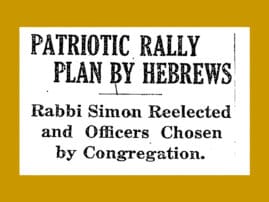Scroll Down
100 Years Ago: WHC and America’s Entry into World War I
By The WHC Archives on April 6, 2017

One hundred years ago, on April 2, 1917, President Woodrow Wilson asked the U.S. Congress to issue a declaration of war on Germany due to that nation’s on-going belligerent activities against American shipping. On April 6, 1917, the Congress declared war on Germany to “make the world safe for democracy,” plunging the United States into World War I.
Washington, D.C. was still a relatively small town in 1917, and its Jewish residents had attained a level of prosperity, prominence, and influence that far exceeded their numbers in the general population. Jews were an integral part of the nation’s capital. Nonetheless, their acceptance was at times tenuous. Overwhelmingly, District of Columbia Jews who were members of Washington Hebrew Congregation were immigrants from Germany or their descendants. As the United States’ relations with Germany began to deteriorate in the years before the war, many Americans began to increasingly question the loyalty and support of Americans of German ancestry. This uncomfortable and even potentially perilous atmosphere compounded the desire on the part of the members of WHC to emphasize their patriotism and Americanism.
A resolution adopted by Washington Hebrew Congregation on April 4, 1917, two days before war was declared said, “RESOLVED…that exercises be had in the matter of raising a United States flag on our Temple to give further evidence of our loyalty and devotion to the Government of the United States….” Four days later, our members and leaders participated in a flag raising ceremony in front of the synagogue, which was then located on 8th Street, to demonstrate their loyalty and support for President Wilson and the war.
This spirited American flag raising event was widely reported in local newspapers. Attended by the entire congregation and its leaders, Rabbi Louis Stern, Rabbi Abram Simon, WHC President Adolf M. Fishel, and Simon Wolf — a former president of the Congregation and perhaps Washington’s most prominent Jew of the 19th and early 20th centuries. Wolf spoke at the flag raising, saying, in part:
“No class of citizenship should take a deeper interest in the outcome of the war than we, for here is our home — our future, our opportunity. … We are assembled as American citizens renewing in this crucial moment our devotion and allegiance to the republic. … Sun kissed and wind tossed, this flag … stands sponsor for religious liberty. … It seeks no other conquest than that of justice and righteousness.”
Rabbi Abram Simon also addressed the crowd, which included representatives from the District’s Christian churches, urging “young men to uphold the sacred honor of the flag by enlisting.” During America’s participation in the war, 60 Temple members (59 men and one woman) and Rabbi Simon himself joined the armed forces, heeding the call to serve.
WHC formed several ad hoc committees — Hospitality, Sunshine, Hospitals, and Red Cross — to help support the war effort, and dozens of Temple members gave significant time to provide aid to “…the men in khaki and to the stranger….” WHC also held Sunday morning services during the war and conducted additional High Holy Day services, all in an effort to provide additional opportunities for worship. WHC, through its Jewish War Relief Campaign raised $50,000 — which today would be nearly one million dollars.
A display of images and artifacts from this historic time will be on display in the case nearest Kreeger Lobby during April.
 Previous Post
Previous Post